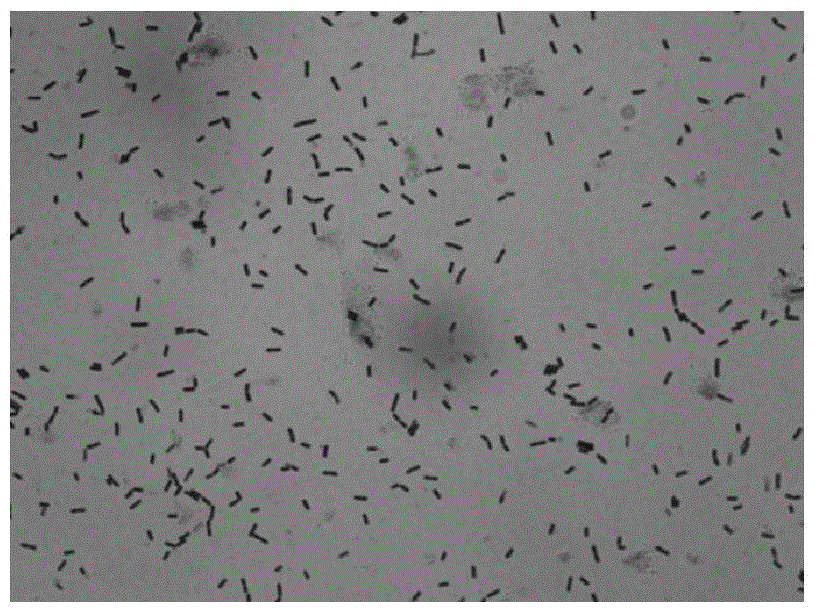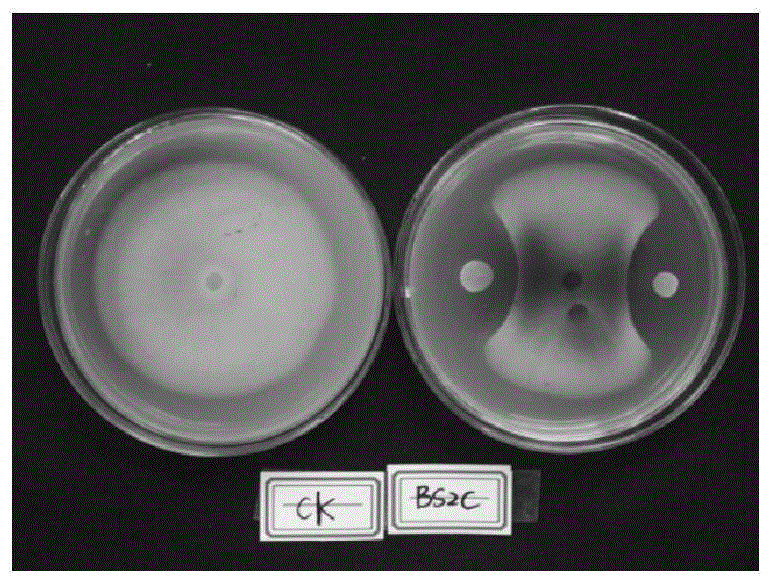Bacillus subtilis Baisha2C for restraining plant pathogenic fungi
A technology for Bacillus subtilis and plant fungal diseases, which is applied in the directions of plant growth regulators, botanical equipment and methods, and microorganism-based methods to achieve the effects of stable antibacterial ability, simple cultivation and strong adaptability
- Summary
- Abstract
- Description
- Claims
- Application Information
AI Technical Summary
Problems solved by technology
Method used
Image
Examples
Embodiment 1
[0026] Isolation, cultivation, screening and purification of biocontrol bacteria Baisha2C.
[0027] 1.1 Sampling
[0028] The samples were the susceptible leaves of pepper in Baisha County, Hainan Province. The collected leaves were put into plastic bags and recorded.
[0029] 1.2 Surface disinfection of materials and separation of antagonistic bacteria
[0030] 1.2.1 Rinse with clean water and cut off diseased leaves
[0031] Wash off the dust and grit on the leaves with clean water and let them dry. Use scissors to cut small leaves with a size of 5 × 5mm at the junction of disease and health for future use.
[0032] 1.2.2 Sample disinfection
[0033] Put the clipped small diseased leaves into a beaker and soak them in mercuric chloride for 30 seconds. During the soaking process, pay attention to constantly stirring the small diseased leaves, then rinse them with sterile water three times, dry them, and set them aside.
[0034] 1.2.3 Bacterial isolation and culture
[0...
Embodiment 2
[0042] Identification of Biocontrol Bacteria Baisha2C
[0043] 1. Microbiological characteristics:
[0044] Observing the morphological characteristics of the biocontrol strains cultivated by streaking in the incubator at 37°C, it was found that the biocontrol strain Baisha2C was rod-shaped, tended to form chains, and had round or square ends; spores were oval, oval, columnar, and round , without a capsule, belonging to the genus Bacillus. After Gram staining, the bacteria showed blue-purple, which was Gram-positive bacteria.
[0045] 2. Molecular biological identification:
[0046] (1) DNA extraction: Genomic DNA was extracted using a general kit in the art;
[0047] (2) PCR reaction: bacterial general primers 8F and 1492R were synthesized by Yingwei Jieji (Shanghai) Trading Co., Ltd., and the structure is as follows: 8F 5'-AGAGTTTGATCCTGGCTCAG-3', 1492R5'-GGTTACCTTGTTACGACTT-3'.
[0048] The 16S rDNA gene amplification results of the biocontrol strain Baisha2C are as fol...
Embodiment 3
[0130] Study on Sensitivity of Biocontrol Bacteria Baisha2C to Antibiotics
[0131] 1) culture medium
[0132] LB solid medium.
[0133] 2) Reagent
[0134] Ampicillin, kanamycin, chloramphenicol, streptomycin, tetracycline, erythromycin, rifampicin, cephalosporin.
[0135] 3) method
[0136] The sensitivity of Bacillus subtilis K13 to non-antibiotics was determined by the filter paper method, and a filter paper disc with a diameter of 7 mm was prepared with a puncher and sterilized at high temperature. Add 1 ml of the seed solution of the tested strain to the LB solid medium cooled to 50-55 degrees Celsius after melting, shake well and pour the plate, put the sterilized filter paper on the plate, and then add the antibiotic solution on the filter paper The amount added is equivalent to ampicillin Amp 50 micrograms per milliliter, kanamycin Kana 50 micrograms per milliliter, chloramphenicol Chl 50 micrograms per milliliter, streptomycin Str 50 micrograms per milliliter, te...
PUM
 Login to View More
Login to View More Abstract
Description
Claims
Application Information
 Login to View More
Login to View More - R&D
- Intellectual Property
- Life Sciences
- Materials
- Tech Scout
- Unparalleled Data Quality
- Higher Quality Content
- 60% Fewer Hallucinations
Browse by: Latest US Patents, China's latest patents, Technical Efficacy Thesaurus, Application Domain, Technology Topic, Popular Technical Reports.
© 2025 PatSnap. All rights reserved.Legal|Privacy policy|Modern Slavery Act Transparency Statement|Sitemap|About US| Contact US: help@patsnap.com



